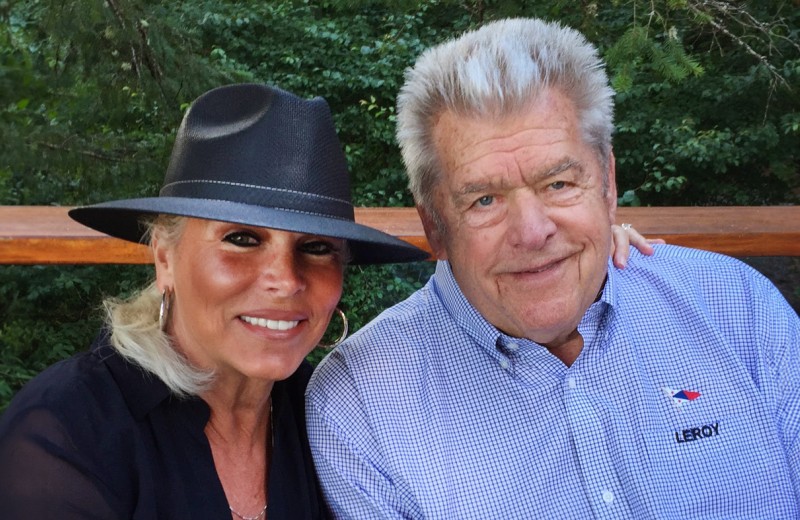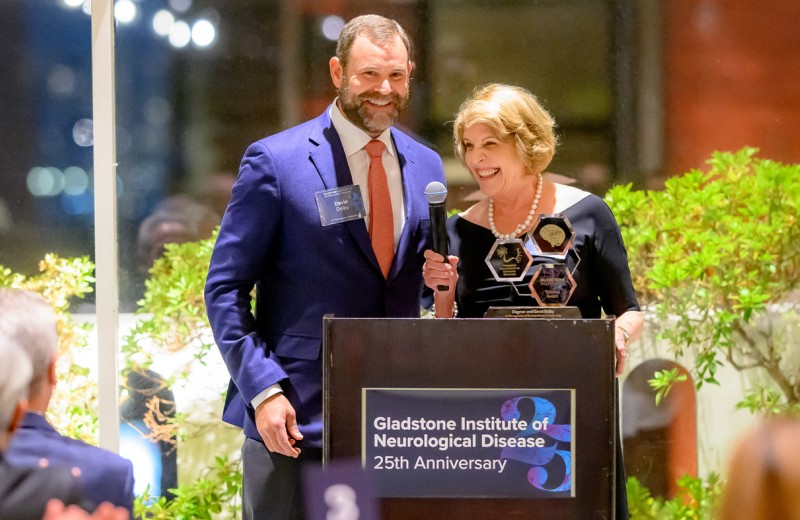Gladstone NOW: The Campaign Join Us on the Journey✕

Linda (left) and Robert (right) Mahley were there from Gladstone's very beginnings. Now, they are philanthropic partners and have included Gladstone in their estate plan.
In conversation with Gladstone’s Philanthropy Team, Robert and Linda Mahley share their wisdom and experiences as founders and philanthropic partners.
When the founding trustees of Gladstone Institutes set out to find a leader for the nascent organization in 1979, their first step was to recruit Robert and Linda Mahley. As Gladstone’s first president, Robert Mahley established the foundation and the culture of leadership that has guided and sustained the organization for over 40 years. Mahley’s scientific research has been pivotal in cardiovascular disease and neurological disorders. He was among the pioneers studying apoE4, a protein associated with a 12-fold increase in risk for Alzheimer’s disease.
As Gladstone grew, adding new institutes and investigators from all over the world, Linda Mahley created an English as a Second Language (ESL) program. A certified ESL teacher trained at UC Berkeley, she has helped new trainees and scientists for more than 20 years. When they relocate to San Francisco to join Gladstone, she provides support for them to overcome the difficulties of being a stranger in a new country with an unfamiliar language and culture.
Can you describe how Gladstone got started?
Forty-two years ago, we were invited to lay the foundation for what would become one of the world’s leading biomedical research institutions. Starting with a card table, seven scientists, and a hand-written sign in a 125-year-old brick building at San Francisco General Hospital, we embarked on the incredible journey of launching Gladstone Institutes with a team of dedicated researchers and staff. Today, Gladstone has a staff of about 450 employees and a state-of-the-art building at Mission Bay.
Why did you decide to include Gladstone in your estate plan?
We wanted to help advance groundbreaking research for future generations. With the proceeds from the sale of the Mahley family farm in Indiana, we established a charitable remainder trust to benefit Gladstone and have also included an additional bequest intention in our estate plans. In doing so, we are honoring four generations of Mahleys who lived and worked on the farm, and who would have been proud of all the efforts of people at Gladstone in pursuing cures for the world’s most devastating diseases.
Why Gladstone?
Gladstone’s tagline is “Science Overcoming Disease.” Gladstone scientists focus on solving the toughest medical problems facing humankind, such as heart disease, Alzheimer’s disease and other neurological disorders, immunological diseases, HIV, and more recently COVID-19. To do so requires unwavering rigor and commitment—Gladstone scientists display this in spades!
What do you find special about Gladstone?
The philosophy at Gladstone from the beginning was to recruit the very best scientists and staff and give them the freedom to follow wherever the science would lead. At the core of this philosophy was an expectation of risk-taking that can ultimately lead to breakthroughs. Gladstone scientists are risk-takers!
Why is philanthropy essential for Gladstone?
The expectation of risk-taking brings with it the necessity to provide scientists with the financial resources to explore the unknown. This type of research is not funded by traditional government grants—so-called safe science. Gladstone seeks to provide scientists with funding that gives them freedom to think outside the box, and they are wisely using these unrestricted funds to advance scientific understanding.
What advice would you give to someone who is considering including Gladstone in their estate plan?
Visit Gladstone and “kick the tires,” so to speak. Get to know the people to see how and where you can make a difference. Gladstone is not a large entity in which a gift can be swallowed up into a large pool; you can have confidence that the funds will be used as you desire and for the purpose you wish. A gift to Gladstone makes a real difference.
What are some of your fondest memories from the past 42 years?
We have watched with pride as Gladstone has evolved from a small entity focusing only on cardiovascular disease to an institution having a significant impact on diseases in the areas of neurology, immunology, virology, and data science. Gladstone scientists are on the cutting-edge of precision medicine, stem cell biology and regenerative medicine, and translational research, moving their discoveries from the laboratory to the clinic. Our fondest memories are from watching generation after generation of young scientists being trained at Gladstone and now populating labs and clinics around the world and taking with them the Gladstone culture of commitment to excellence, integrity, and teamwork. Gladstone is known as a family, and “once Gladstone, always Gladstone” wherever they are!
Moving from a comfortable position at the NIH to found Gladstone was risky. Why did you take that leap of faith?
J. David Gladstone, a real estate and shopping center developer in Los Angeles, left his entire estate for the purpose of creating something new and different. He named three trustees—two attorneys and a businessman—and charged them with the task of creating the vision for a free-standing, administratively independent biomedical research institute associated with an outstanding medical school, UC San Francisco. It was the trustees who sold us on this vision. Their instructions were to create the best institution possible with the highest quality biomedical research and make a difference for the lives of people around the world with our work. Gladstone remains focused on that task after 42 years!
Support Discovery Science
Your gift to Gladstone will allow our researchers to pursue high-quality science, focus on disease, and train the next generation of scientific thought leaders.
Embracing Change: Darlene Hines Shares Her Journey of Growth, Resilience, and Giving Back
Embracing Change: Darlene Hines Shares Her Journey of Growth, Resilience, and Giving Back
Longtime Gladstone supporter Darlene Hines reflects on her journey of learning, growth, and giving after her husband’s passing
Donor StoriesVisionary Philanthropists Establish Center to Harness Computational Biology for Cancer Research
Visionary Philanthropists Establish Center to Harness Computational Biology for Cancer Research
A search for the brightest minds in cancer and AI led Hope and Sanjit Biswas to give in their own backyard.
Philanthropy Donor Stories Cancer Biswas Center for Transformative Computational Cancer Biology Data Science and Biotechnology Pollard Lab AI Big DataThe Risk and the Reward
The Risk and the Reward
How the Dolby family works to improve outcomes for people with Alzheimer’s disease
Donor Stories Alzheimer’s Disease



